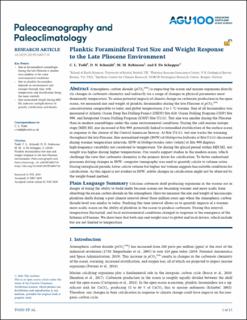| dc.description.abstract | Atmospheric carbon dioxide (pCO2atm) is impacting the ocean and marine organisms directly via changes in carbonate chemistry and indirectly via a range of changes in physical parameters most dominantly temperature. To assess potential impacts of climate change on carbonate production in the open ocean, we measured size and weight of planktic foraminifers during the late Pliocene at pCO2atm concentrations comparable to today and global temperatures 2 to 3 °C warmer. Size of all foraminifers was measured at Atlantic Ocean Deep Sea Drilling Project (DSDP) Site 610, Ocean Drilling Program (ODP) Site 999, and Integrated Ocean Drilling Program (IODP) Site U1313. Test size was smaller during the Pliocene than in modern assemblages under the same environmental conditions. During the cold marine isotope stage (MIS) M2, size increased at Site 999, potentially linked to intensified stratification of the surface ocean in response to the closure of the Central American Seaway. At Site U1313, test size tracks the warming throughout the late Pliocene. Size‐normalized weight (SNW) of Globigerina bulloides at Site U1313 decreased during warmer temperature intervals. SNW of Globigerinoides ruber (white) at Site 999 displays high‐frequency variability not correlated to temperature. Yet during the glacial period within MIS M2, test weight was higher during higher temperatures. Our results support studies in the modern ocean, which challenge the view that carbonate chemistry is the primary driver for calcification. To better understand processes driving changes in SNW, computer tomography was used to quantify calcite to volume ratios. During interglacial periods, lower calcite volume but higher test volume suggests less suitable conditions for calcification. As this signal is not evident in SNW, subtle changes in calcification might not be observed by the weight‐based method. | |

